The NASA Electronic Parts and Packaging (NEPP) '02 Workshop
The NASA Electronic Parts and Packaging (NEPP) '02 Workshop
The NASA Electronic Parts and Packaging (NEPP) '02 Workshop
You also want an ePaper? Increase the reach of your titles
YUMPU automatically turns print PDFs into web optimized ePapers that Google loves.
Abstracts ________________________<br />
Session 3 – LaRC-MFC Technology<br />
Overview of <strong>NASA</strong>-Langley Macro-Fiber Composite (MFC)<br />
Piezoelectric Actuator Technology<br />
W. Keats Wilkie<br />
Army Research Laboratory; <strong>NASA</strong> Langley Research Center<br />
w.k.wilkie@larc.nasa.gov<br />
Tel: 757/864-1260 FAX: 757/864-8808<br />
Abstract<br />
<strong>The</strong> Macro-Fiber Composite actuator (MFC) is a high performance<br />
piezoelectric composite device developed by <strong>NASA</strong> Langley<br />
Research Center <strong>and</strong> the Army Research Laboratory. <strong>The</strong> MFC<br />
was initially created to control vibrations <strong>and</strong> deformations in<br />
composite helicopter rotor blades. It has since found use in a wide<br />
range of uses, in particular, with inflatable-rigidizable composite<br />
spacecraft applications. <strong>The</strong> MFC's features include high work<br />
output, low weight, low power requirements, low manufacturing<br />
cost, <strong>and</strong> repeatable properties <strong>and</strong> performance. An overview of<br />
the design history, manufacture, <strong>and</strong> performance testing of the<br />
MFC actuator device will be presented here. A summary of<br />
ongoing MFC applications research will also be given.<br />
Speaker Biography<br />
Keats Wilkie received a B.S. in applied physics from the University<br />
of Alabama in 1986. He holds an M.S. degree in Engineering<br />
Science <strong>and</strong> Mechanics from the Georgia Institute of Technology<br />
(1990), <strong>and</strong> M.S. <strong>and</strong> Ph.D. degrees in Aerospace Engineering<br />
Sciences from the University of Colorado at Boulder (1995, 1997).<br />
He has been a research aerospace engineer with the U.S. Army<br />
Research Laboratory, <strong>and</strong> detailed to <strong>NASA</strong> Langley Research<br />
Center, since 1986. His research areas include structural dynamics<br />
<strong>and</strong> control, rotary wing dynamics, <strong>and</strong> active structures <strong>and</strong><br />
actuator design. He currently leads <strong>NASA</strong>-Langley's Macro-Fiber<br />
Composite Actuator development efforts.<br />
Design <strong>and</strong> Characterization of Radial Field Diaphragms<br />
Robert G. Bryant<br />
<strong>NASA</strong> Langley Research Center<br />
MS 226, Hampton, VA 23681<br />
Abstract<br />
Radial Field Diaphragms “RFD” are <strong>NASA</strong> Langley’s latest<br />
piezoelectric ceramic actuators. <strong>The</strong> RFD uses an in-situ radial<br />
electric field to displace a piezoelectric element along the Z-axis<br />
(out of plane). <strong>The</strong> unique feature of these actuators is that they<br />
display concentric deformation <strong>and</strong> thus, are not benders. This<br />
allows these diaphragms to be mechanically constrained about<br />
their perimeter without dramatically affecting their performance.<br />
<strong>The</strong> fabrication of these diaphragms is based on that of <strong>NASA</strong>’s<br />
Macrofiber Composite ”MFC” (currently under <strong>NEPP</strong> evolution).<br />
This talk will focus on the ongoing selection criteria, fabrication<br />
process, basic characterization <strong>and</strong> initial results of these RFDs<br />
prior to higher-level evaluation required for potential mission<br />
support. <strong>The</strong>re are several uses for this new type of actuator<br />
including sonic transducers, diaphragm pumps, active valves <strong>and</strong><br />
dynamic sensors.<br />
13<br />
Speaker Biography<br />
Robert G. Bryant received a BS in Chemistry with minors in Math<br />
<strong>and</strong> Physics from Valparaiso University in 1985. He graduated from<br />
the University of Akron with an MS (1990) <strong>and</strong> a Ph.D. (1995) in<br />
Polymer Science under an <strong>NASA</strong> GSRP fellowship. Since 1990, he<br />
has been employed at <strong>NASA</strong> Langley Research Center as a Senior<br />
Chemical Engineer in the Advanced Materials <strong>and</strong> Processing<br />
Branch. His current research interests include the development of<br />
smart materials <strong>and</strong> subsystems, new material hybrids, fabrication<br />
technology, <strong>and</strong> material concepts for electronics. Dr. Bryant holds<br />
over 15 patents, approximately 50 publications, <strong>and</strong> has several<br />
licensed inventions. He has earned three <strong>NASA</strong> Group<br />
Achievement Awards, the <strong>NASA</strong> Holloway, Whitcomb, <strong>and</strong> TGIR,<br />
the Medal of Exceptional Achievement, three R&D 100 Awards<br />
(including editor's choice), <strong>and</strong> the Valparaiso University Alumni<br />
Achievement <strong>and</strong> Outst<strong>and</strong>ing Young Alumni Awards. Currently, he<br />
holds adjunct professorships at the College of William <strong>and</strong> Mary,<br />
Virginia Tech, <strong>and</strong> Virginia Commonwealth University. Professional<br />
memberships include the American Chemical Society (ACS) <strong>and</strong><br />
IMAPS.<br />
Additional Information:<br />
Dr. Robert G. Bryant<br />
<strong>NASA</strong> Langley Research Center<br />
Research <strong>and</strong> Technology Competencies<br />
Structures <strong>and</strong> Materials Competency<br />
Advanced Materials <strong>and</strong> Processing Branch<br />
Mail Stop 226<br />
6 West Taylor Street<br />
Hampton, VA 23681-2199<br />
Phone: 757-864-4262<br />
Fax: 757-864-8312<br />
E-mail: r.g.bryant@larc.nasa.gov<br />
Reliability Testing of MFC Actuators<br />
James W. High 3 , W. K. Wilkie 2 , <strong>and</strong> James F. Bockman 1<br />
<strong>NASA</strong> Langley Research Center<br />
MS 488 1 , 230 2 , 390 3<br />
Hampton, VA 23681<br />
Abstract<br />
<strong>NASA</strong> Langley Research Center (LaRC) has developed Micro-<br />
Fiber Composite (MFC) actuators as a core enabler to control<br />
vibrations in extremely large inflatable smart space structures, next<br />
generation space telescopes, etc. Test show that the LaRC-MFC<br />
actuator is capable of producing large, directional in-plane strains,<br />
on the order of 2000 parts-per-million (ppm). Preliminary ambient<br />
endurance testing indicates that the device is durable, with no<br />
reductions in free-strain performance to at least 100 million<br />
electrical cycles. This paper describes methods, measurements,<br />
<strong>and</strong> results for our reliability evaluation of the LaRC-MFC under<br />
strained conditions.<br />
Speaker Biography<br />
James W. High is currently assigned to the <strong>Electronic</strong>s Applications<br />
Technology Branch at <strong>NASA</strong> Langley Research Center. He is a<br />
1996 graduate of the <strong>NASA</strong> Technical Apprentice School. He<br />
received an Associate in Applied Science (AAS) degree in<br />
<strong>Electronic</strong>s from Thomas Nelson Community College in 1994. Prior<br />
to coming to work for <strong>NASA</strong>, Mr. High was employed as a licensed<br />
Master electrician.



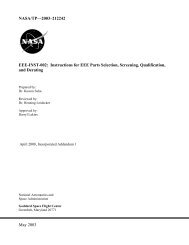

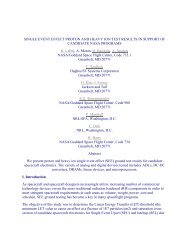
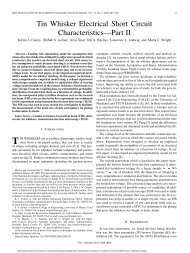
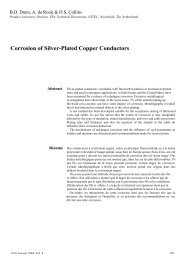
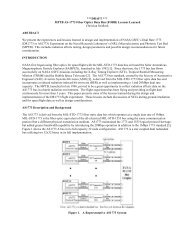

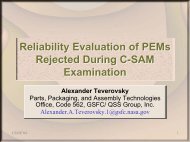
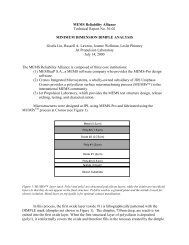
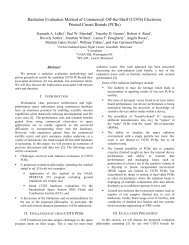
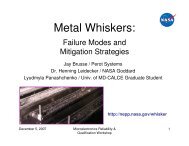
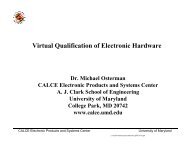
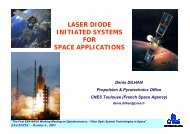
![mil-std-2223 [test methods for insulated electric wire] - NEPP](https://img.yumpu.com/4036001/1/190x249/mil-std-2223-test-methods-for-insulated-electric-wire-nepp.jpg?quality=85)